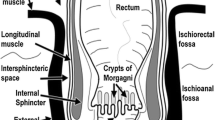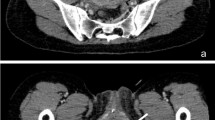Abstract
Aim
Due to the paucity of data and controversy regarding the etiology and surgical approach for managing anorectal prolapse (ARP) after anorectoplasty, we sought to investigate the underlying anatomic disorder and the surgical outcome in managing this challenging complication.
Methods
We performed a retrospective study on 83 patients with ARP related to anorectal malformations (ARM). Logistic regression analyses were performed to detect the risk factors for the ARP severity. Surgical procedures were stratified according to identified anatomical abnormalities and surgical outcomes were analyzed.
Results
50 patients (62.7%) had high-type ARM. The original anorectoplasty had a higher rate of ARP in laparoscopic-assisted anorectoplasty (n = 49, 59.0%) versus posterior sagittal anorectoplasty (n = 11, 13.3%). ARP was associated with rectal fat hyperplasia (67.5%), dilated muscular tunnel (79.5%), longitudinal muscle (LM) discontinuity (16.9%), rectal dilation (22.9%), mislocated anus (7.2%), and excessive mobile mesorectum (3.6%). Based on the ARP severity, the patients were divided into a severe group (Group 1, n = 38) and a moderate group (Group 2, n = 45). Binary logistic regression analysis showed that hyperplasia rectal fat (OR 4.55, 95% CI 1.16–17.84), rectal dilation (OR 4.21, 95% CI 1.05–16.94), and high-type ARM (OR 2.90, 95% CI 1.14–7.39) were independent risk factors for the development of severe ARP. Complications after stratified surgical repair included wound infection in six patients (7.2%), anal stenosis in one patient (1.2%), and ARP recurrence in two patients (2.4%). Twenty-six patients without colostomy before prolapse repair were followed up for 2 to 12 years. All the patients maintained voluntary bowel movements. Following ARP repair, there was an overall higher rate of no soiling or grade 1 soiling (88.5 vs. 65.4%), but 3 of 12 patients with grade 2 constipation were upgraded to grade 3.
Conclusion
Our study shows that ARM-related anorectal prolapse is associated with excessive rectum, hyperplasia of rectal fat, mobile mesorectum, loose muscular tunnel, LM discontinuity, and anal mislocation. Surgical repair with techniques stratified according to the patients’ underlying risk factors is effective to prevent recurrence and improve the soiling continence.










Similar content being viewed by others
References
Belizon A, Levitt M, Shoshany G et al (2005) Rectal prolapse following posterior sagittal anorectoplasty for anorectal malformations. J Pediatr Surg 40(1):192–196. https://doi.org/10.1016/j.jpedsurg.2004.09.035
Sato H, Furuta S, Kawase H et al (2012) The long-term prognosis of two-flap anoplasty for mucosal prolapse following anorectoplasty for anal atresia. Pediatr Surg Int 28(8):841–846. https://doi.org/10.1007/s00383-012-3129-z
Zornoza M, Molina E, Cerdá J et al (2012) Postoperative anal prolapse in patients with anorectal malformations: 16 years of experience. Cir Pediatr 25(3):140–144
Brisighelli G, Di Cesare A, Morandi A et al (2014) Classification and management of rectal prolapse after anorectoplasty for anorectal malformations. Pediatr Surg Int 30(8):783–789. https://doi.org/10.1007/s00383-014-3533-7
Pathak M, Saxena AK (2020) Postoperative “complications” following laparoscopic-assisted anorectoplasty: a systematic review. Pediatr Surg Int 36(11):1299–1307. https://doi.org/10.1007/s00383-020-04748-3
Kimura O, Iwai N, Sasaki Y et al (2010) Laparoscopic versus open abdominoperineal rectoplasty for infants with high-type anorectal malformation. J Pediatr Surg 45(12):2390–2393. https://doi.org/10.1016/j.jpedsurg.2010.08.042
Cares K, El-Baba M (2016) Rectal prolapse in children: significance and management. Curr Gastroenterol Rep 18(5):22. https://doi.org/10.1007/s11894-016-0496-y
D’Hoore A, Jones OM (2018) Rectal prolapse and associated pelvic organ prolapse syndromes. In: Knowles CH, Keighley MR, Williams NS (eds) Keighley & Williams’ Surgery of the Anus, Rectum and Colon, vol 1, 4th edn. CRC Press, pp 378–423
Schmidt D, Jenetzky E, Zwink N et al (2012) Postoperative complications in adults with anorectal malformation: a need for transition German Network for Congenital Uro-REctal Malformations (CURE-Net). Pediatr Surg Int 28(8):793–795. https://doi.org/10.1007/s00383-012-3120-8
Wood RJ, Halleran DR, Ahmad H et al (2020) Assessing the benefit of reoperations in patients who suffer from fecal incontinence after repair of their anorectal malformation. J Pediatr Surg 55(10):2159–2165. https://doi.org/10.1016/j.jpedsurg.2020.06.011
Millard DR Jr, Rowe MI (1984) Plastic surgical principles in high imperforate anus. Plast Reconstr Surg 19(5):577–580. https://doi.org/10.1016/s0022-3468(84)80108-6
Davies MR, Cywes S (1984) The use of a lateral skin-flap perineoplasty in congenital anorectal malformations. J Pediatr Surg 19(5):577–580. https://doi.org/10.1016/s0022-3468(84)80108-6
De La Torre L, Zornoza M, Peña A et al (2020) Transanal rectal mucosectomy and muscular plication: a new technique for rectal prolapse in patients with an anorectal malformation. J Pediatr Surg 55(11):2531–2535. https://doi.org/10.1016/j.jpedsurg.2020.05.025
Koivusalo AI, Pakarinen MP, Rintala RJ (2014) Rectopexy for paediatric rectal prolapse: good outcomes but not without postoperative problems. Pediatr Surg Int 30(8):839–845. https://doi.org/10.1007/s00383-014-3534-6
Elhaddad A, Amerstorfer EE, Singer G et al (2018) Laparoscopic posterior rectopexy (Well’s procedure) for full-thickness rectal prolapse following laparoscopic repair of an anorectal malformation: a case report. Int J Surg Case Rep 42:187–190. https://doi.org/10.1016/j.ijscr.2017.12.020
Leung JL, Chung PH, Tam PK et al (2016) Application of anchoring stitch prevents rectal prolapse in laparoscopic assisted anorectal pullthrough. J Pediatr Surg 51(12):2113–2116. https://doi.org/10.1016/j.jpedsurg.2016.09.051
Ishimaru T, Hosokawa T, Kawashima H et al (2020) Rectal prolapse after laparoscopically assisted anorectoplasty for anorectal malformations. J Laparoendosc Adv Surg Tech A 30(12):1277–1281. https://doi.org/10.1089/lap.2020.0609
Holschneider A, Hutson J, Peña A et al (2005) Preliminary report on the international conference for the development of standards for the treatment of anorectal malformations. J Pediatr Surg 40(10):1521–1526. https://doi.org/10.1016/j.jpedsurg.2005.08.002
Li L, Ming A, Zhou Y et al (2021) Refinements in surgical techniques for visualized tunnel formation in laparoscopic-assisted anorectoplasty. Pediatr Surg Int 37(8):999–1005. https://doi.org/10.1007/s00383-021-04909-y
Ming AX, Li L, Diao M et al (2014) Long term outcomes of laparoscopic-assisted anorectoplasty: a comparison study with posterior sagittal anorectoplasty. J Pediatr Surg 49(4):560–563. https://doi.org/10.1016/j.jpedsurg.2013.11.060
Jung SM, Lee SK, Seo JM (2013) Experience with laparoscopic-assisted anorectal pull-through in 25 males with anorectal malformation and rectourethral or rectovesical fistulae: postoperative complications and functional results. J Pediatr Surg 48(3):591–596. https://doi.org/10.1016/j.jpedsurg.2012.08.001
Son J, Kim W, Jung SM et al (2020) Minimal dissection of posterior wall of rectum reduces rectal prolapse in laparoscopic assisted anorectal pull-through. J Pediatr Surg 55(9):1969–1973. https://doi.org/10.1016/j.jpedsurg.2020.05.026
Li L, Ren X, Xiao H et al (2020) Normal anorectal musculatures and changes in anorectal malformation. Pediatr Surg In 36(1):103–111. https://doi.org/10.1007/s00383-019-04583-1
Macchi V, Porzionato A, Stecco C et al (2008) Histo-topographic study of the longitudinal anal muscle. Clin Anat 21(5):447–452. https://doi.org/10.1002/ca.20633
Shafik A (1987) A concept of the anatomy of the anal sphincter mechanism and the physiology of defecation. Dis Colon Rectum 30(12):970–982. https://doi.org/10.1007/BF02554289
Peña A, Grasshoff S, Levitt M (2007) Reoperations in anorectal malformations. J Pediatr Surg 42(2):318–325. https://doi.org/10.1016/j.jpedsurg.2006.10.034
Puri P, Nixon HH (1976) Levatorplasty: a secondary operation for fecal incontinence following primary operation for anorectal agenesis. J Pediatr Surg 11(1):77–82. https://doi.org/10.1016/0022-3468(76)90173-1
Pearl RH, Ein SH, Churchill B (1989) Posterior sagittal anorectoplasty for pediatric recurrent rectal prolapse. J Pediatr Surg 24(10):1100–1102. https://doi.org/10.1016/s0022-3468(89)80228-3
Funding
This work was supported by the CAMS Innovation Fund for Medical Sciences (2021RU015).
Author information
Authors and Affiliations
Corresponding authors
Ethics declarations
Conflict of interest
The authors have no conflict of interest to disclose.
Research involving human participants
Ethical approval was obtained from the Ethics Committee of the Capital Institute of Pediatrics.
Informed consent
Written informed consents were obtained from the parents before surgery.
Additional information
Publisher's Note
Springer Nature remains neutral with regard to jurisdictional claims in published maps and institutional affiliations.
Rights and permissions
About this article
Cite this article
Li, L., Zhou, Y., Ming, A. et al. Pattern of anatomic disorder and surgical management of anorectal prolapse in anorectal malformation. Pediatr Surg Int 38, 993–1004 (2022). https://doi.org/10.1007/s00383-022-05141-y
Accepted:
Published:
Issue Date:
DOI: https://doi.org/10.1007/s00383-022-05141-y




